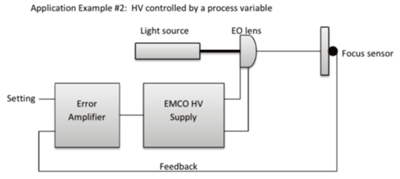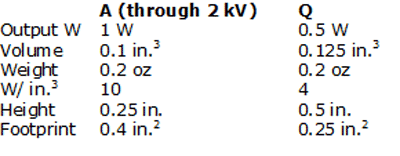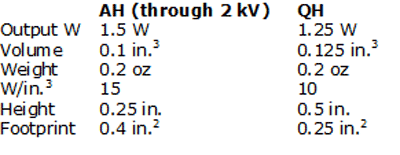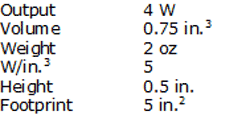Next-generation, miniature high-voltage power modules
EMCO white paper
The first generation of high-voltage power modules changed the way designers could use high voltage, and the next generation is pushing the envelope further.
The low-voltage revolution
The wide availability of miniature low-voltage power modules inspired a sea change in the architecture of power distribution. Small, lightweight modules could be mounted right at the devices they were energizing. No longer was it necessary to build a main power supply outputting the different voltages and power levels required by the wide variety of subsystems and circuits. This required long runs of power wire sized for the total needs of the system, one set for each voltage. The modularized approach enabled using a single isolated dc bus with a standard supply feeding each circuit.
High-voltage faces the same challenge
High voltage quickly moved to modular localized solutions also, but high voltage has to be treated very differently. A high-voltage power supply designer faces the same problems as low-voltage designers, plus the additional constraints of physics, chemistry, and topology. In the past, this task was left to specialists who usually had to create a new design for each application — there was very little standardization. High-voltage supplies tended to be oversized for their power rating in order to allow for extra spacing of the internal wiring and components. Then there was the problem of safely routing the high-voltage output to its load. As the number of applications requiring high voltage grew, there was pressure to change this early design strategy.
To meet this challenge, high-voltage power supply manufacturers designed proprietary methods to build off-the-shelf modules in very small standard packages that could be used in much the same way as low-voltage power modules. In order to produce high voltage, you need a transformer plus rectifiers and capacitors. At 60 Hz, these components have to be large. The first-generation HV module designers therefore understood that the key to significantly reducing size was to work at relatively high frequencies rather than 60 Hz.
Their approach was to start with low-voltage dc, typically in the range of 12 to 28 Vdc, and then to use an oscillator-based inverter circuit to produce a low-voltage, high-frequency input for the transformer.
High frequency enabled extreme reductions in size, especially for the transformers and capacitors. However, high-voltage engineers were still faced with a serious problem that low-voltage engineers didn’t have to worry about — the possibility of arcing between high voltage points and between high voltage and ground. This meant that there were limits to how small these supplies could be made, and still ensure reliable operation. High voltage never stops looking for, and creating, pathways to escape being confined; therefore unique topologies were developed to achieve the long-term reliability demanded by end users.
Another part of the solution to that problem was in developing encapsulation techniques that enabled the spacing for high voltages to be significantly reduced, while at the same time allowing for adequate heat dissipation.
The first generation arrives
Armed with these tools, EMCO High Voltage Corporation and others developed families of reliable, miniature, small-footprint standard modules, which they built in large numbers, thus enabling users to count on their availability for new designs. The modules are generally available in two basic types:
• Proportional, where the output voltage varies as a function of the input.
• Regulated, where the output is stabilized and controlled by internal components.
Proportional supplies are less expensive and provide more power per-cubic-inch. They can be used in several different ways. If the voltage required by the load is not critical — for example, for electrostatic air cleaners — a proportional supply can be used without special control circuits. The output voltage can be adjusted by varying the input. If the high voltage needs to be constant and the load current doesn’t vary widely, it may be sufficient to use a stable low voltage for the input.

Application Example #1 shows a proportional high-voltage supply applying bias to the grid of a photomultiplier tube. Since the grid draws virtually zero load current, the high-voltage bias can easily be kept at a constant level because its low-voltage input is taken from a regulated source.
Regulated supplies
If the output needs to be extremely stable, it can be regulated against variations of load current, input voltage, temperature, and drifting over time. This can be done by sampling the output voltage and feeding it to an error amplifier that controls the dc input.
If the high-voltage supply is feeding a device that is part of a manufacturing or instrumentation process, the feedback for the error amplifier can be taken from a process variable, rather than directly from the high-voltage output.

Application Example #2 illustrates a high-voltage supply controlling an electro-optic lens. The system as a whole is kept stable because the feedback signal that controls the high voltage is taken from an optical focus sensor. This technique regulates the entire process rather than just the high voltage.
The next generation is here
Over the past 10 years, dc-to-dc high-voltage converters have proven themselves to be effective, efficient, and reliable. The newest generation is retaining those qualities and is further pushing the boundaries of watts per cubic inch, reduced power consumption, and the addition of smart features for control and safety. Comparing the present generation of several EMCO high-voltage power supplies with the models that they have replaced provides a good illustration of these trends.
FS series
The following table compares the current generation FS series 10-W power supplies with its predecessor, the F series.

Important new smart features have been added to the FS module:
• A host-controlled TTL high on pin 8 disables the output.
• A TTL high alarm on pin 6 signals the host that an excess temperature or overvoltage fault has occurred.
• When the fault condition has been cleared, the output is automatically restored but the alarm signal remains until it is reset.
Q series
The industry-standard, ultraminiature Q series has several new models and optional features. Constant product evolution ensures that it will continue to retain its status as the industry standard well into the future.
• The QH series has 2.5x the output power in the same package, up through 5 kV.
• An optional center tap provides plus and minus symmetrical outputs with respect to ground, up through ±450 Vdc.
• A custom 0.400-in.-high version is available.
• An optional high-input impedance control pin can be used (up through 5 kV) for:
Controlling the high-voltage output from an error amplifier for use in a closed-loop regulator circuit.
On/Off control from a logic circuit.
A series
The ultraminiature A series takes miniaturization even further; based on the Q series topology, it provides more output power, but is significantly smaller and lighter.
• Standard power

• Higher power

This series of miniature regulated and programmable high-voltage supplies is designed for battery-powered portable equipment. It is used for mobile and airborne applications where weight, payload size, and long periods of remote operation are required. It provides output power of up to 4 W and can operate no-load for up to 4,500 hours from two lithium AA batteries.

External connections
• Input: +5.4 to 7.4 V
• Input: shut down -TTL – active high
• Output: voltage monitor: 0 to +2.5 V
• Output: voltage reference: +2.5 V
• Input: programming: 0 to +2.5 V
State of the art
The trends described here demonstrate that high-voltage suppliers are continually seeking ways to provide end-users ever expanding choices for off-the-shelf, drop-in miniature solutions to their high-voltage needs. ■
Advertisement
Learn more about Emco High Voltage





